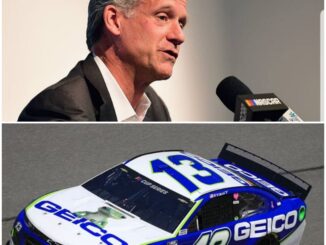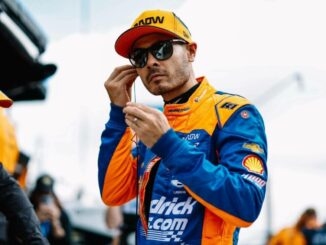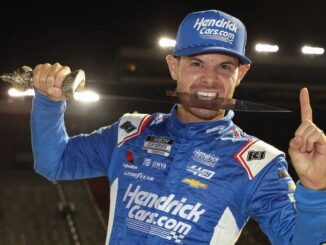
Roger Penske Touts Notion of Future IndyCar-NASCAR Doubleheader Weekends
In a bold move that could reshape the landscape of American motorsport, legendary team owner Roger Penske recently championed the idea of future IndyCar-NASCAR doubleheader weekends. This concept, which would see the two premier motorsport series in the United States compete on the same weekend at the same venue, has sparked significant excitement and conversation within the racing world. Penske, known for his strategic vision and influential presence in motorsport, believes that such events could be the key to revitalizing interest in both series, expanding their fanbases, and creating a spectacle unlike anything seen before in North American racing.
Penske, who owns both the IndyCar Series and the prestigious Indianapolis Motor Speedway (IMS), is no stranger to groundbreaking moves in the motorsport world. His track record speaks volumes, from his domination of the Indy 500 to his significant success in NASCAR with his Penske Racing team. The idea of cross-promoting these two iconic series is the latest in a series of forward-thinking concepts that Penske has put forward to elevate the status of motorsport in America.
The Vision for Doubleheader Weekends
Roger Penske’s vision for IndyCar and NASCAR doubleheader weekends is rooted in the idea of bringing the best of both worlds together. NASCAR, which is predominantly an oval racing series, and IndyCar, known for its open-wheel racing and diverse set of road courses and oval tracks, have historically been separate entities, each with its distinct fanbase and unique appeal. However, Penske sees an opportunity for synergy, creating events where fans of both series can come together and enjoy the thrill of motorsport over a single weekend.
The concept involves scheduling a NASCAR race and an IndyCar race at the same venue, ideally on back-to-back days, in order to maximize attendance, media coverage, and fan engagement. Fans could watch a high-speed NASCAR race on a Saturday, followed by an action-packed IndyCar race on Sunday, or vice versa. Penske’s idea is not just about creating an event that is convenient for fans—it’s about creating an immersive, high-energy weekend of motorsport that brings together two of the most popular forms of racing in the United States.
The Benefits of Doubleheader Weekends
Penske’s enthusiasm for doubleheader weekends is based on several potential benefits that such events could bring to the sport. First and foremost, doubleheader weekends would serve to increase the exposure of both series, attracting a broader audience and encouraging cross-fan engagement. By holding races for both IndyCar and NASCAR on the same weekend, fans of each series who may not regularly follow the other would have the opportunity to witness firsthand the skill and excitement that each style of racing offers. This could lead to increased viewership and attendance for both IndyCar and NASCAR, helping to fuel the growth of both series.
Moreover, Penske envisions doubleheader weekends as a way to promote diversity in motorsport. Many fans of NASCAR may not be as familiar with the intricacies of IndyCar racing, and vice versa. A doubleheader weekend could be an excellent way to introduce fans of one series to the other, potentially leading to greater crossover between the two fanbases. This could also help to elevate the profile of drivers in both series, giving IndyCar drivers more exposure to the NASCAR audience and NASCAR drivers more exposure to the IndyCar audience.
Another significant advantage of doubleheader weekends is the economic impact. A well-promoted doubleheader event could draw larger crowds, meaning higher attendance and increased revenue from ticket sales, hospitality, concessions, and merchandising. A weekend filled with races from both series could turn a single event into a major spectacle, drawing in corporate sponsors and media attention that would otherwise be difficult to generate for either series alone.
Challenges and Logistics
While the potential benefits are clear, organizing IndyCar-NASCAR doubleheader weekends would come with its share of challenges. One of the main hurdles would be the logistics of scheduling races for two entirely different racing formats. NASCAR races, with their longer race durations and different technical demands, require significant preparation in terms of track layout and timing. IndyCar races, which often involve more complex pit strategies and varying types of tracks, would need a different set of accommodations. Balancing these two unique racing styles while ensuring each race runs smoothly could require significant collaboration between NASCAR, IndyCar, and track organizers.
Another potential obstacle is the issue of driver participation. While some NASCAR drivers, like Kurt Busch and Tony Stewart, have expressed interest in participating in IndyCar races in the past, the logistics of allowing drivers to participate in both series on the same weekend could be complicated. The physical and mental demands of competing in two races in such a short timeframe might be too much for some drivers, who would need to balance their commitments to both series. Additionally, the different car setups, race strategies, and levels of competition in each series could make it difficult for drivers to perform at their best in both events.
Scheduling also remains a significant consideration. NASCAR and IndyCar each have their own tightly packed race calendars, and finding weekends that work for both series could be challenging. The events would likely need to take place at venues that can accommodate both types of racing, such as the Indianapolis Motor Speedway, which is already home to both IndyCar’s Indianapolis 500 and NASCAR’s Brickyard 400.
Potential Venues for Doubleheader Weekends
For Penske’s vision to become a reality, selecting the right venues is crucial. The Indianapolis Motor Speedway is an obvious choice, given its status as one of the most iconic motorsport venues in the world and Penske’s ownership of the facility. The venue already hosts both IndyCar and NASCAR races, making it a logical starting point for future doubleheader weekends.
Other venues that could potentially host these events include tracks like Pocono Raceway, Texas Motor Speedway, and Daytona International Speedway. These venues are equipped to handle the different needs of both IndyCar and NASCAR and could offer the type of atmosphere that Penske envisions for a successful doubleheader weekend. Selecting tracks that can provide diverse and exciting racing experiences for fans will be critical to ensuring the success of these events.
The Bigger Picture for Motorsport in America
Penske’s idea for doubleheader weekends speaks to a larger goal of revitalizing motorsport in America. In recent years, there has been a growing interest in expanding motorsports’ reach beyond traditional fanbases. Doubleheader weekends featuring both IndyCar and NASCAR could be a major step in that direction. It’s a chance to appeal to a new generation of fans who are increasingly looking for diverse and engaging entertainment experiences.
By combining the spectacle of both IndyCar and NASCAR in one action-packed weekend, Penske aims to create an event that transcends the boundaries of individual racing series and showcases the best of American motorsport. For fans, the prospect of seeing two major races in one weekend could be an unforgettable experience that strengthens the overall appeal of racing in the United States.
Conclusion
Roger Penske’s vision of future IndyCar-NASCAR doubleheader weekends is an exciting prospect for the world of motorsport. With the potential to bring together the passionate fanbases of both series, boost economic opportunities, and offer thrilling racing action, this idea could be a game-changer for the sport in the United States. While there are certainly challenges ahead, Penske’s leadership and his track record of success in motorsport suggest that the notion of doubleheader weekends is more than just a pipe dream—it could be the next evolution in American racing. If successfully implemented, these events could go a long way in shaping the future of motorsport in America for years to come.



Be the first to comment